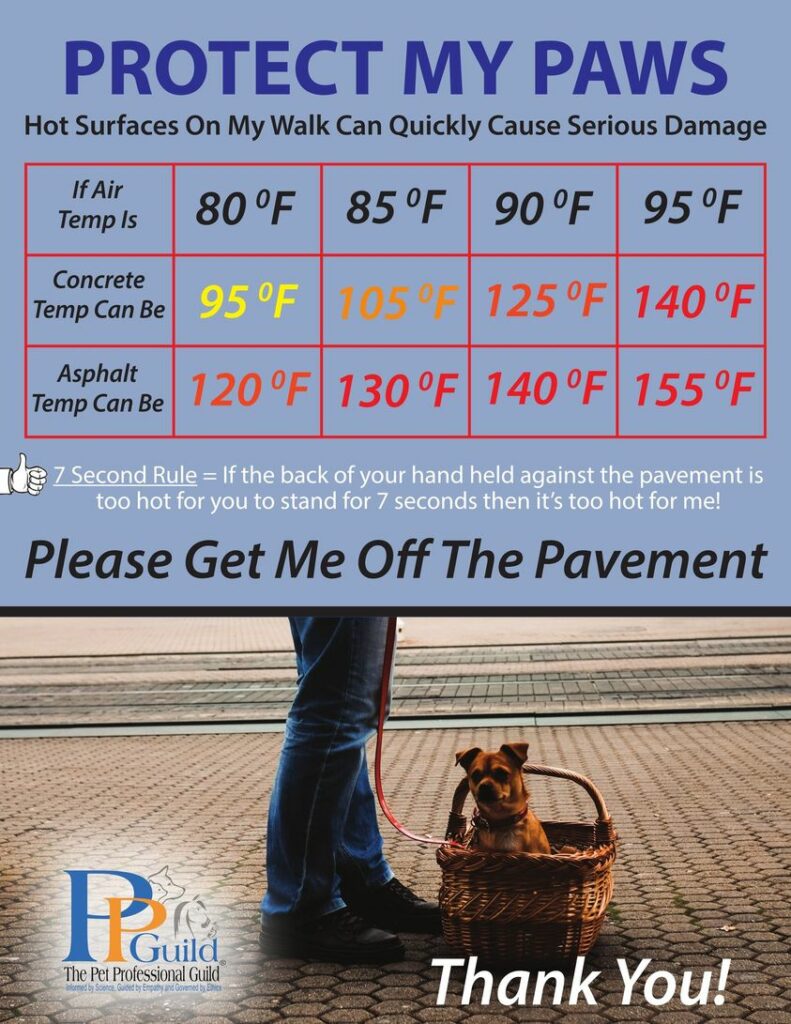Pets and Their People Blog
Summer Is Here – Protect Your Pets!
This information does not replace the advice or instruction given to you by your veterinarian.
Summer is when dogs are most at risk of being affected by heatstroke. A dog’s normal body temperature is 100°F to 102.5°F but, unlike humans, dogs do not have sweat glands throughout their skin. Their only methods for cooling include limited sweat glands on the pads of their feet and nose, and panting. Both of these are inefficient at cooling their body temperatures in extreme situations. If a dog cannot effectively dissipate heat, their internal body temperature begins to rise. Once the dog’s temperature exceeds 104°, damage to their body’s cellular system and organs may become irreversible. With heatstroke the cells literally cook.
Have you ever said to yourself: “I’m just going to run into the store for a minute, my dog will be fine in the car?” Well, including the time to walk to the store from your car, shopping, and checkout, a minute is never just a minute. A study by the Animal Protection Institute showed that even moderately warm outside temperatures can quickly lead to deadly temperatures inside a closed car. In just a few minutes the internal temperature of a car can easily reach 40° higher than the outside temperature, even if parked in the shade with the windows cracked open. Being left in a car is the number one cause of heatstroke in dogs.
Although exercise is essential for a happy and healthy dog, be sure to choose a time of day, during hot months, that is safe for heavy activity and pay close attention to how your dog is responding. Owners with breeds such as Pugs, English Bulldogs and Boston Terriers need to be especially attentive to their pet’s needs, as they are less tolerant of heat. When you are playing and exercising outside, always make sure your dog has plenty of fresh cool water and access to a shaded area at all times. Be sure to take frequent breaks and allow your dog to cool down before resuming activity. If you take walks, try to go in the early morning or in the evening and remember to take water with you.

How Do You Know if Your Dog May Have Heatstroke?
Some of the Symptoms Include:
- A rectal temperature over 104 ° F (needs immediate veterinary attention)
- A rectal temperature of 106 °F or greater (dire emergency)
- Excessive panting
- Bright red gums and tongue
- Gums feel dry to the touch
- Thick saliva
- Excessive shaking
- Staggering
- Lying down and refusing or unable to get back up
What to Do if You Suspect Your Dog May Be Affected by Heatstroke:
- Remove your dog from the hot environment.
- Immediately get a rectal temperature if possible.
- DO NOT submerge or saturate your dog with cold water or ice!! (This may make internal damage more severe).
- Place cool, wet rags or washcloths on major blood vessels such as the jugular vein (along the neck) and the femoral artery (inside the rear leg). Replace often.
- Slightly dampen your dog with lukewarm water and place directly in front of a fan to safely wick away heat- Do not soak!
- Offer your dog cool water to drink but do not force water into the mouth.
- The most effective treatment is with IV fluids and medications administered by your veterinarian!
- Call or visit your vet right away – even if your dog seems better. Internal damage might not be obvious to the naked eye, so an exam is necessary (and further testing may be recommended).
Some dogs can fully recover from heatstroke if it is caught and treated early by a veterinarian. Prognosis of treatment for heatstroke is significantly affected by how high a temperature the body reaches, and the length of time the dog was exposed to dangerous levels. A delay in treatment for 2 hours may result in a 70 percent chance of death. Sadly, many dogs affected by heatstroke do not survive. Prevention is the key to keeping your dog safe during warmer weather, so be sure to make proper accommodations.
Written by Bethany Jordan CVT. Copyright 2021 DogSmith

